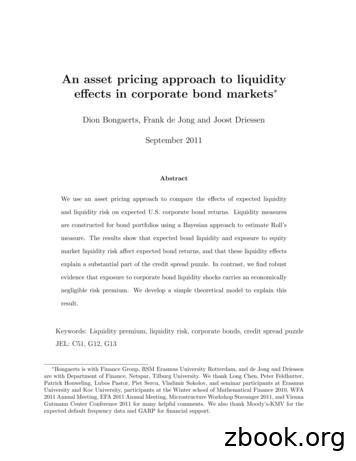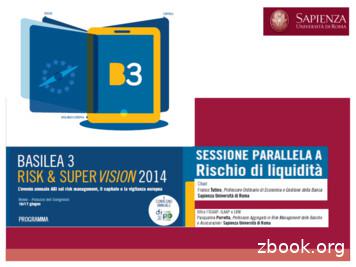Chapter 3 Order flow, Liquidity And Securities Price Dynamics
Chapter 3Order flow, Liquidity andSecurities Price Dynamics1
3.8Exercises2. Bid-ask spread and insider trading. A small risky company’s stock is wortheither 10 (v L ) or 20 (v H ) with probability12each (θ 1 θ 0.5).a. Compute the bid and ask prices set by risk neutral competitive market makersin the absence of informed trading.b. Compute the bid and ask prices set by risk neutral competitive market makerswhen they expect one in ten of trade initiators to be informed (to know the stock’strue value) and to trade as profit maximizers, while the other nine out of ten areuninformed and buy or sell with equal probability. Assume that all transactions areof the same size.c. Compute the average trading cost to an uninformed trader and the averagegain to an informed one, assuming a unit trade size in both cases.d. Do you agree with the following statement? “Insider trading does not harmmost market participants: it harms only those who are unlucky enough to trade withan insider.” Why? Refer to the example in this exercise to illustrate your argument.4. Endogenous information acquisition by insiders in the Glosten-Milgrommodel. Consider the one-period Glosten-Milgrom model, where the security’s truevalue v can be high (v H ) or low (v L ) with probability12each. Market makers arecompetitive and risk neutral, and do not know v. In each period, a single tradercomes to the market: with probability 1 π, he is a “noise trader,” who buys orsells one unit with probability12each; with probability π he is a “potential insider,”who learns the security’s true value v if he pays a cost c, in which case he will tradeon his information to make a profit. (If he does not elect to acquire information, hedoes not trade.)2
a. Compute the bid and ask prices and the bid-ask spread that market makersset, assuming that they believe the insider will acquire information with some givenprobability ' 2 [0, 1]?b. Given these prices, determine the trading profit of an insider who has decidedto acquire information.c. Determine the condition on the cost parameter c in terms of π and v H v Lunder which the potential insider will never choose to acquire information, even inthe most auspicious situation in which market makers do not expect to face anyinsider trading (i.e., ' 0).d. Determine the condition on the cost parameter c in terms of π and v H v Lunder which the potential insider will always choose to acquire information, even inthe least auspicious situation in which market makers expect to face insider tradingwith probability π (i.e., ' 1).e. Now consider intermediate values of c for which neither of the conditionsdetermined under (c) and (d) is satisfied. Determine the value of ' that will makethe potential insider indi§erent between acquiring and not acquiring information.This endogenous value of ' describes a “mixed-strategy equilibrium” in which theinsider randomizes between the two options. How does this value of ' depend onthe parameters of the model? Explain your results intuitively.f. Characterize the equilibrium in the three ranges of the values of c consideredin (c), (d), and (e). Plot the bid-ask spread and the potential insider’s net expectedprofit as a function of the cost c of acquiring information. Explain your graphintuitively.3
3.9SolutionsExercise 2:a. Under these assumptions, there is no bid-ask spread since the probability ofinformed trading, π, is equal to 0. Ask and bid prices are both equal to µ, whereµ (v H v L )2 (10 20)2 15.b. Under these assumptions the probability of informed trading is π 1/10,that can be used in the general expressions for bid and ask prices provided in theGlosten-Milgrom model:a µ 0.1 · 12 · 12πθ(1 θ)HL(v v) 15 (20 10) 15 0.5 15.5,πθ (1 π) 120.1 · 12 0.9 · 12and0.1 · 12 · 12πθ(1 θ)HLb µ (v v ) 15 (20 10) 15 0.5 14.5.πθ (1 π) 120.1 · 12 0.9 · 12Hence the absolute bid-ask spread isS a b 1.c. An uninformed trader who trades a unit of the security pays a trading cost of 0.5 whilst the expected gain for an informed trader is [(20 15.5) · 0.5 (14.5 10) · 0.5] 4.5. The market maker is operating at zero profits since his expectedprofits are [(0.5) · 0.9 (4.5) · 0.1] 0.45 0.45 0.d.Insider traders do not harm only those who trade with them. As shown atpoint (c) market makers recoup the losses they make because of informed trading bycharging the bid-ask spread to all their customers. Basically uninformed traders paythe cost arising from informed trading, even if they do not trade directly with them.Exercise 4:4
a. Market makers know that the probability of receiving an order from an uninformed trader is 1 π, the probability of receiving an order from an informed traderis π', and the probability of receiving no order (which occurs when the potentiallyinformed trader did not discover the information) is π(1 '). Hence, the ask priceisH v Lπ'v H (1 π) va π' (1 π)2and the bid price isHLπ'v L (1 π) v v2b .π' (1 π)Hence the absolute bid-ask spread isS a b π'(v H v L ),π' (1 π)(3.63)which is increasing in ': if potential insiders discover the information with greaterlikelihood, there will be more adverse selection and therefore a larger spread.b. An insider who observes v v H and buys at the ask price makes a profit ofH v Lπ'v H (1 π) vv a v π' (1 π)HH2 11 π(v H v L ).2 π' (1 π)Symmetrically, if he observes v v L and sells at the bid price makes the same profit:H v Lπ'v H (1 π) vb v π' (1 π)L2 vL 11 π(v H v L ).2 π' (1 π)If the potential insider invests in information collection, he earns the first amounthalf of the time (when he observes v v H ) and the second (identical) amount theother half of the time (when he observes v v L ), and pays the cost c. Hence, hisnet expected profit is11 π(v H v L ) c.2 π' (1 π)5(3.64)
c. No information is collected ifc 11 π(v H v L ).2 π' (1 π)(3.65)Since the right-hand side of (3.65) is decreasing in ', it is largest for ' 0. Hence, ifit holds for ' 0, it will also hold for ' 0. Hence, no information will be collectedif1c (v H v L ),2(3.66)which is condition (3.65) for ' 0.d. By the same argument presented under (c), the right-hand side of condition(3.65) is smallest for ' 1. Hence if this condition is violated for ' 1, it will beviolated for any ' 2 [0, 1]. Hence, information collection is always profitable if1c (1 π)(v H v L ).2(3.67)which is condition (3.65) for ' 1.e. The potential insider is indi§erent between collecting and not collecting information if condition (3.65) holds with equality instead of inequality:c 11 π(v H v L ),2 π' (1 π)that is, if1 π' π !"1 vH vL 1 .2cf. If condition (3.67) holds, then ' 1 and S π(v H v L ).If condition (3.66) holds, then ' 0 and S 0.In the intermediate region where11(1 π)(v H v L ) c (v H v L ),226(3.68)
the bid-ask is given by the general expression (3.63) derived under point (i), whichupon substituting from (3.68) becomesS 1 vH2c. vL(3.69)This expression is decreasing in the information collection cost c: intuitively, a highercost discourages information collection (lowers ' ), thus reducing the probability ofinformed trading (lowers π' ) and the implied adverse selection problems. The bidask spread in this intermediate region is still increasing in fundamental volatilityv H v L : intuitively, greater volatility raises the profits from informed trading (asshown at point (b)) and thereby encourages information collection (lowers ' ), , thusincreasing the probability of informed trading (lowers π' ) and the implied adverseselection problems.Figure 3.1 puts together the previous results in a single graph: for low valuesof the information collection cost c potential insiders always seek information andthe bid-ask spread S is highest (at S π(v H v L )); for intermediate values of thiscost, it decreases linearly in c as shown by (3.69); for high values of the cost c, noinformation is collected and the bid-ask spread S becomes zero.Figure 3.2 instead plots the net profit of the informed trader. For low valuesof the information collection cost c, this profit is obtained by setting ' 1 inexpression (3.64). For intermediate values, the profit is zero, because the potentialinsider chooses ' precisely to be indi§erent between being informed and uninformed:this can be verified by substituting ' from (3.68) in expression (3.64).7
Sπ (v H v L )1 1(1 π )(v H v L )22cvH vH1 H(v v L )2cFigure 3.1: Bid-ask spread S and information collection cost cnet profit ofinformedtrader1(1 π )(v H v L ) c21(1 π )(v H v L )2cFigure 3.2: Informed trader’s net profit and information collection cost c8
each. Market makers are competitive and risk neutral, and do not know v.Ineachperiod,asingletrader comes to the market: with probability 1 π,heisa“noisetrader,”whobuysor sells one unit with probability 1 2 each; with probability π he is a “potent
level) and various forms of liquidity risk (both equity market liquidity risk and corporate bond liquidity risk). We do this using a formal asset pricing approach. Given that liquidity level and liquidity risk exposures are typically highly correlated, neglecting either the liquidity level or liquidity risk may lead to misleading conclusions on the
Part One: Heir of Ash Chapter 1 Chapter 2 Chapter 3 Chapter 4 Chapter 5 Chapter 6 Chapter 7 Chapter 8 Chapter 9 Chapter 10 Chapter 11 Chapter 12 Chapter 13 Chapter 14 Chapter 15 Chapter 16 Chapter 17 Chapter 18 Chapter 19 Chapter 20 Chapter 21 Chapter 22 Chapter 23 Chapter 24 Chapter 25 Chapter 26 Chapter 27 Chapter 28 Chapter 29 Chapter 30 .
lowers market liquidity, leading to higher volatility. Further, under certain conditions, low future market liquidity increases the risk of flnancing a trade, thus increasing margins. Based on the links between funding and market liquidity, we provide a unifled explanation for the main empirical features of market liquidity.
During the liquidity crisis, observed funding and market liquidity mutually reinforce one another. A small negative shock to the economy might be amplified through this mechanism and result in a sudden drying-up of the liquidity. During the financial crisis, policy interventions are expected to alleviate the liquidity crunch.
Use of capital requirements creates regulatory arbitrage 3. The degree to which regulations act as . Assumes that there are no systemic liquidity needs “A Theory of Bank Liquidity Requirements” . Liquidity only part of the new regulatory toolkit Are liquidity and capital regulations complements? Substitutes? Liquidity regulation is .
Principi basilari comuni alle guidelines, principles in materia di Liquidity Risk Management (LRM): definizione rischio/rischi di liquidità (funding, market, contingency liquidity risk); determinazione di un livello di liquidity risk appetite e liquidity risk tolerance; presenza di una, policy per la gestione della liquidità (Liquidity policy, Funding Liquidity policy, Collateral .
TO KILL A MOCKINGBIRD. Contents Dedication Epigraph Part One Chapter 1 Chapter 2 Chapter 3 Chapter 4 Chapter 5 Chapter 6 Chapter 7 Chapter 8 Chapter 9 Chapter 10 Chapter 11 Part Two Chapter 12 Chapter 13 Chapter 14 Chapter 15 Chapter 16 Chapter 17 Chapter 18. Chapter 19 Chapter 20 Chapter 21 Chapter 22 Chapter 23 Chapter 24 Chapter 25 Chapter 26
DEDICATION PART ONE Chapter 1 Chapter 2 Chapter 3 Chapter 4 Chapter 5 Chapter 6 Chapter 7 Chapter 8 Chapter 9 Chapter 10 Chapter 11 PART TWO Chapter 12 Chapter 13 Chapter 14 Chapter 15 Chapter 16 Chapter 17 Chapter 18 Chapter 19 Chapter 20 Chapter 21 Chapter 22 Chapter 23 .























